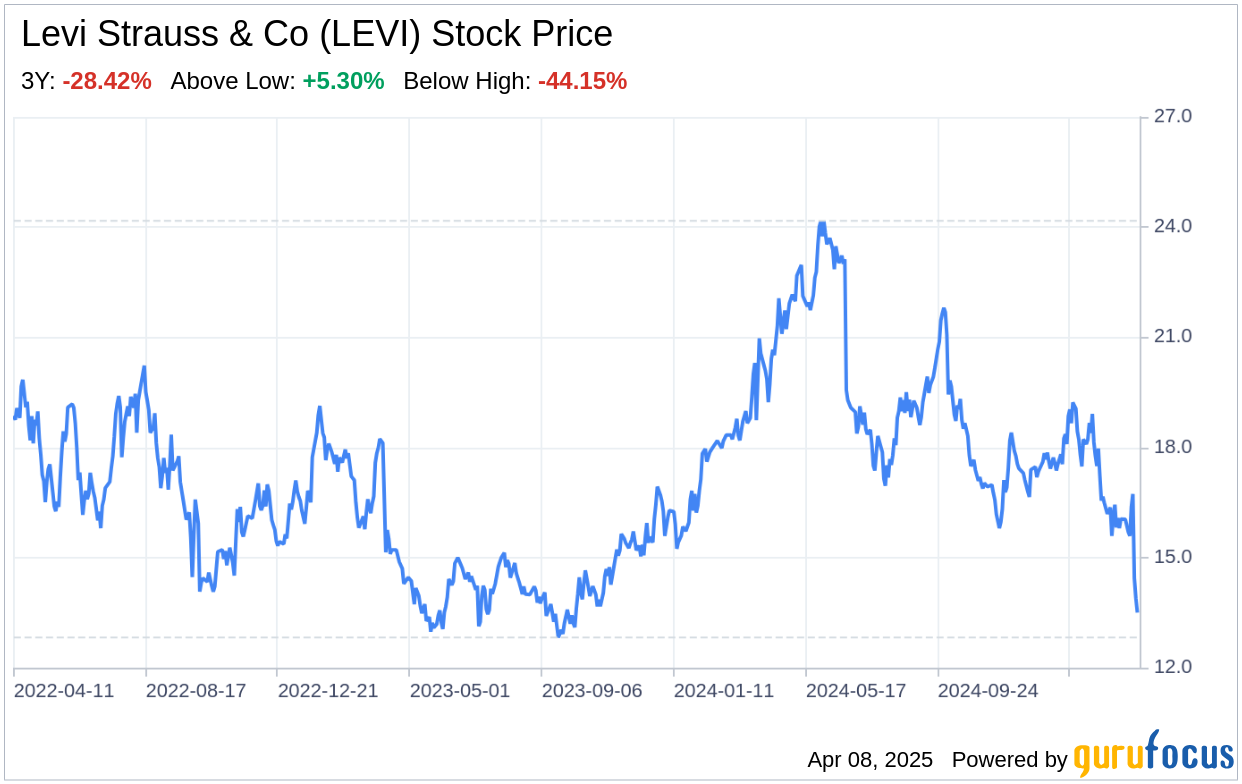Levi Strauss & Co (LEVI, Financial), a global leader in the apparel industry, has released its 10-Q filing on April 7, 2025, providing a detailed look into its financial performance and strategic positioning. The company, renowned for its iconic denim and casual wear, operates under the Levi's, Dockers, Signature by Levi Strauss & Co., and Denizen brands. With a strong presence across the Americas, Europe, and Asia, LEVI has demonstrated resilience and adaptability in a dynamic market. The latest financial tables reveal a year-over-year increase in net revenues from $1,480.2 million to $1,526.8 million, a commendable gross profit rise from $869.8 million to $947.6 million, and a striking turnaround in net income from a loss of $10.6 million to a profit of $135.0 million. These figures underscore LEVI's financial robustness and its ability to navigate market challenges effectively.

Strengths
Brand Power and Market Position: LEVI's strength lies in its iconic brand and market position. The company's brand equity is built on a legacy of quality and innovation, resonating with consumers globally. This is evidenced by the year-over-year revenue growth of 3.1%, reflecting the brand's enduring appeal and effective marketing strategies. The gross profit margin has also seen an increase from 58.8% to 62.1%, showcasing LEVI's ability to maintain profitability amidst market fluctuations. Moreover, the company's diversified product range, including jeans, casual wear, and accessories, caters to a broad customer base, further solidifying its market standing.
Financial Resilience: LEVI's financial resilience is a testament to its strong balance sheet and prudent fiscal management. The significant recovery in operating income, from a mere $0.6 million to $191.6 million, highlights the company's operational efficiency and cost-control measures. Additionally, the reduction in cost of goods sold by 5.1% indicates LEVI's success in optimizing its supply chain and production processes, contributing to its financial stability.
Weaknesses
Brand Portfolio Management: While LEVI's brand portfolio is a strength, it also presents a weakness in terms of brand portfolio management. The discontinuation of the Denizen brand and the strategic review of the Dockers business indicate challenges in maintaining relevance and profitability across all brands. These decisions, although strategic, suggest a need for continuous evaluation and adaptation of the brand mix to align with market trends and consumer preferences.
Dependency on Wholesale Channel: LEVI's reliance on the wholesale channel, which generated 48% of net revenues, exposes the company to the risks associated with third-party retailers. This includes potential store closures, bankruptcies, and shifts in consumer shopping behavior towards direct-to-consumer (DTC) channels. As the retail landscape evolves, LEVI must enhance its DTC capabilities to reduce dependency on wholesale and mitigate associated risks.
Opportunities
Direct-to-Consumer Expansion: The growing trend towards DTC sales presents a significant opportunity for LEVI. With 52% of net revenues generated through DTC channels, the company is well-positioned to capitalize on this shift. Expanding its e-commerce platform and company-operated stores can lead to higher margins, greater brand control, and enhanced customer engagement. Additionally, leveraging digital technologies can provide valuable consumer insights and drive personalized marketing efforts.
Global Market Penetration: LEVI's international presence, contributing 57% of net revenues, offers opportunities for further market penetration, especially in emerging economies. By tailoring product offerings and marketing strategies to local tastes and preferences, LEVI can capture new customer segments and increase its global footprint. Strategic partnerships and localized campaigns can also enhance brand visibility and drive growth in these markets.
Threats
Economic Pressures and Tariffs: The global economic environment, characterized by inflation, energy price volatility, and new U.S. tariffs, poses a threat to LEVI's operations. These factors can lead to increased production costs, reduced consumer spending, and disruptions in the supply chain. LEVI must navigate these challenges carefully to maintain its profitability and market position.
Competitive Landscape: The apparel industry is highly competitive, with numerous players vying for market share. LEVI faces competition from both established brands and emerging players, particularly in the fast-fashion segment. To remain competitive, LEVI must continue to innovate, offer compelling product assortments, and deliver exceptional customer experiences across all channels.
In conclusion, Levi Strauss & Co (LEVI, Financial) demonstrates a strong financial foundation and brand equity, which are pivotal to its market success. However, challenges in brand portfolio management and reliance on the wholesale channel are areas that require strategic attention. Opportunities for DTC expansion and global market penetration are promising avenues for growth, while economic pressures and a competitive landscape are significant threats that must be managed. LEVI's forward-looking strategies, focused on leveraging its strengths and addressing its weaknesses, will be crucial in sustaining its competitive edge and driving long-term shareholder value.
This article, generated by GuruFocus, is designed to provide general insights and is not tailored financial advice. Our commentary is rooted in historical data and analyst projections, utilizing an impartial methodology, and is not intended to serve as specific investment guidance. It does not formulate a recommendation to purchase or divest any stock and does not consider individual investment objectives or financial circumstances. Our objective is to deliver long-term, fundamental data-driven analysis. Be aware that our analysis might not incorporate the most recent, price-sensitive company announcements or qualitative information. GuruFocus holds no position in the stocks mentioned herein.
